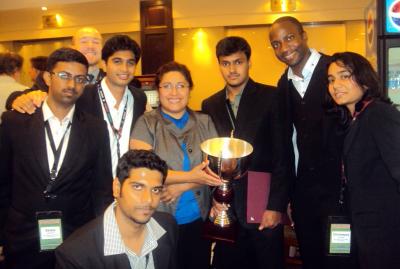NMSU team excels in PACE international competition

Two New Mexico State University engineering students and their Michigan Tech, Universidad Iberoamerican (Mexico), People's Education Society Institute of Technology (India) and Sri Jayachamara-jendra College of Engineering (India) teammates overcame these challenges to earn second place in the Partners for the Advancement of Collaborative Engineering Education (PACE) Sustainable Urban Transportation competition at the 2012 PACE Global Annual Forum, held in Shanghai July 23-27.
Only three points separated Team No. 3, the NMSU team, from the first place team.
Industrial engineering graduate student Ntengwa Mukosa and mechanical engineering senior Jason Wright spent the last year working with NMSU team adviser Delia Valles- Rosales, industrial engineering professor, as well as James Knight, Alejandra Carrasco, Eliana Nunez and Kristina Padilla, students from the Department of Industrial Engineering, and teammates in both India and Mexico, to design the Agriya, a car designed specifically for use in Ahmedavad, India.
Ahmedavad is a city of more than 5.5 million people and cars there must be small and functional. The PACE competition also required that the cars be developed sustainably.
"The Agriya is a very unique vehicle, designed to be a two-seater with trunk space and interior space to transport things," Wright said. "This car was designed specifically for use in India."
Because the city is large and petroleum is expensive and in decreasing supply there, the Agriya is powered completely by electricity and is able to park, even in the tightest of spots, as the suspension was designed to allow 90 degree parallel parking capability and turns of 360 degrees, with no radius, according to Mukosa.
"Most of the teams did something unique," Valles-Rosales said, referring to the parking example.
The Agriya was designed with reusable parts - for instance, the seats in the car can be removed and used as seats in the home. Affordability and functionality also were considered with every aspect of the car, as was the ergonomic design. Mukosa and Wright developed an ergonomic sequential design method that drew the attention of conference organizers, so much so, in fact, that they were invited to give a technical paper presentation on their method.
The majority of the judges for the SUT competition came from General Motors, Siemens, Oracle, HP and Autodesk, all sponsors of PACE. The Aggie team noted that the environment at PACE is so friendly that students are able to speak directly with the CEOs, recruiters and other representatives of these companies. The job and general networking opportunities are above average for PACE students.
"One of the biggest things that PACE offers students is exposure," Mukosa said. "That's something that you can't pay for. Money can't buy exposure."
PACE provides computer hardware and software, training, automotive parts, and industry-related projects to the engineering and design departments at a select group of universities around the world. This type of support to universities like NMSU, provides students an edge through exposure to and experience with the technical software and systems used by industry.
Some of the other participating U.S. schools are Northwestern, Virginia Tech and the University of Pennsylvania. Schools from Brazil, Canada, China, Germany, India, Mexico, South Korea and Italy also participated in this year's competition.
"It says something when you come from NMSU and you compare yourself to universities that are working directly with General Motors and designing Formula One vehicles," Mukosa said. "You can see how you personally fit as a puzzle piece into a career of professional engineering."
This year was NMSU's first year to have a team compete at PACE; Valles-Rosales, Mukosa and Wright hope that many more NMSU teams will find success and professional development with PACE in the future.


